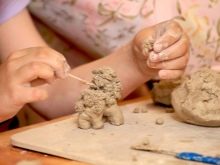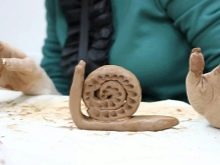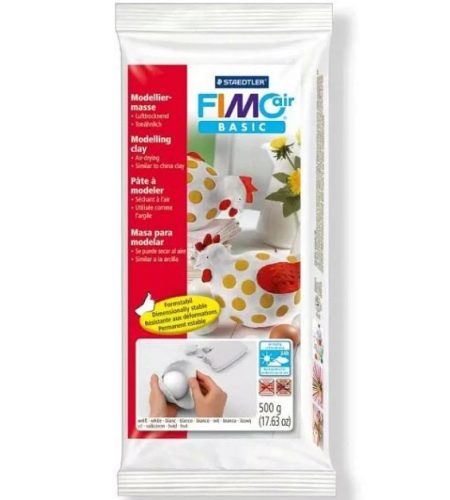All About Self-Hardening Modeling Clay

Recently, self-hardening clay has become an increasingly popular material for the manufacture of various crafts. This material has its own characteristics, which should be understood before starting sculpting.
What it is?
Self-hardening modeling clay is a plastic mass that begins to harden quickly in the open air. The hardening time of the material depends on the type of clay, the thickness of the molded product and other parameters.
Clay was first produced in 1930. Then the material was used to sculpt the heads of dolls, which were put up for sale in toy stores. Over time, self-hardening polymer began to be used to create jewelry, decorative elements.



Views
Self-hardening clay modeling is a popular hobby that is gaining popularity every year. Today manufacturers offer a wide range of clays of different compositions and characteristics. It is worth considering the main types of material.
Polymer
This clay is also called plastic. This is a special mass that resembles plasticine in its composition and appearance. For the production of the material, plasticizers, PVC and dyes are used.
Pros of polymer clay:
- large selection of shades;
- high rate of elasticity;
- softness.
Among the minuses, the presence of a pungent smell of burnt rubber is distinguished, which makes the modeling not so attractive.



Natural
Clay of natural origin, mined from the bowels of the earth. The packaged mass does not require the addition of dyes. The shade of the material is formed by nature. Benefits of natural clay:
- safety of use;
- hypoallergenic;
- small price.
Among the disadvantages, it is worth highlighting a harder consistency, which is difficult to mold.



How to choose?
In the process of work, each master determines his favorite in the form of a certain type of clay, which is suitable for modeling. It is rarely possible to find among a wide variety of materials the one you need the first time, so you should carefully approach the purchase.
A few tips will help in choosing the right material:
- when buying, it is worth clarifying all the information about the manufacturer, whose product seemed attractive;
- be sure to pay attention to the date of manufacture of the goods and the expiration date;
- it is recommended to choose packaging without damage, since any deformation can lead to a deterioration in the properties of the material;
- it is worth choosing in advance the tool with which the products will be sculpted.



Finally, when choosing polymer clay, you should give preference to products that match the selected color combinations. Otherwise, a finished craft of incongruous shades will look unattractive. Purchasing white clay is a good solution.
A quality material should have such characteristics as:
- viscosity;
- plastic;
- elasticity;
- hardness;
- strength.
In addition, experienced craftsmen recommend before going to the store to decide on the product that you want to dazzle.



Popular manufacturers
On the shelves of art stores, you can find various types of polymer clays from different manufacturers. Below is a ranking of popular brands selling quality products.
Darwi
The manufacturer's clay is used to model products of any complexity: from flowers to real sculptures. The material dries outdoors at normal room humidity. The company offers several varieties of clay, among which Darwi Extra Light and Darwi Porcelaine are popular.
Complete drying of the product occurs within 24 hours. Clay lends itself to drying in ovens, does not deform.

La doll
The plastic of the Japanese manufacturer is appreciated for the naturalness of the components of the composition, one of which is cellulose. The clay is safe to use, has a high quality and quick solidification in the open air. It will be easy even for an inexperienced creator to work with the material.


Paperclay delight
The brand produces lightweight plastic, which hardens within 24-72 hours. The term depends on the type of material and the layer thickness of the finished product. Pros of the manufacturer's clay:
- low price;
- environmental friendliness;
- safety of use;
- light weight when solidified.
It is noteworthy that even after hardening, the clay material retains its strength. The only drawback is that the clay is highly flammable, so drying the plastic in the oven is excluded.


Paperclay creative
The manufacturer is engaged in the production of natural clays, the hardening of which occurs in the open air. It is better not to put finished products from this material in the oven. Advantages:
- lack of a sugary smell;
- papier-mâché effect due to cellulose fibers;
- environmental friendliness.
The material is non-toxic, which makes sculpting possible with children. Plastic is suitable for creating products of any complexity. To connect the parts, the masters recommend moistening the joint with water and smoothing out irregularities.


Efa Plast
The manufacturer is distinguished by the release of reliable polymer products. In total, the company has two main lines. The latter option contains cellulose in its composition, which made it possible to reduce the weight of the polymer and improve the strength of the material.
Basically, flowers or insect wings are made from Efa Plast clay. However, if you wish, you can create a complex structure.

What can be blinded?
Polymer clay is a popular material from which you can mold almost anything you can imagine. With your own hands, using self-hardening plastic, you will be able to create:
- decorations;
- flowers;
- sculptural elements.
More experienced craftsmen are able to sculpt real masterpieces from clay, which later become decorations for exhibitions or houses. You can do everything with your own hands from a pliable and elastic material if you choose the right plastic.


Storage tips
Self-hardening clay is afraid of water, which can destroy the entire structure. Therefore, first of all, it is worth making sure that the finished product is dried in a room with normal humidity and is far from any source of liquid.
Additionally, the masters advise to cover the creations with acrylic varnish. Coating steps.
- First, the master sculpts the product.
- Next, the sculpture or other decorative element is dried. It can be natural drying in the open air or artificially.
- The third option involves painting the hardened product with high quality paints.
- The next stage is the next drying. In this case, wait until the paint layer hardens.


Finally, the last step is to apply the varnish. In this case, the product is covered with a protective composition in 2 layers. As for the choice of varnish, preference should be given to matte options. However, glossy is able to add brightness and shine to the product.
Self-hardening clay is popular for its ease of use, variety of shades and environmental friendliness.









